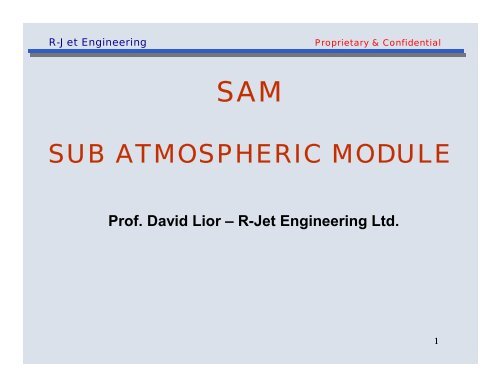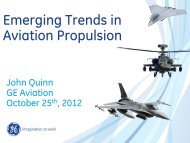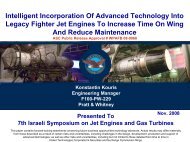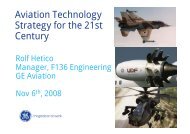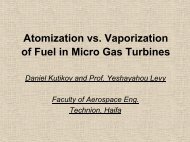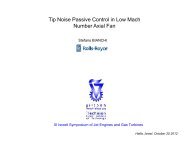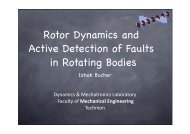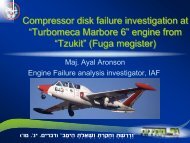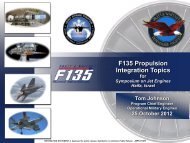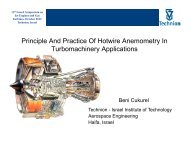T.S 550 Sub-Atmospheric Module - Turbo & Jet Engine Research ...
T.S 550 Sub-Atmospheric Module - Turbo & Jet Engine Research ...
T.S 550 Sub-Atmospheric Module - Turbo & Jet Engine Research ...
You also want an ePaper? Increase the reach of your titles
YUMPU automatically turns print PDFs into web optimized ePapers that Google loves.
R-<strong>Jet</strong> <strong>Engine</strong>ering<br />
Proprietary & Confidential<br />
SAM<br />
SUB ATMOSPHERIC MODULE<br />
Prof. David Lior – R-<strong>Jet</strong> <strong>Engine</strong>ering Ltd.<br />
1
R-<strong>Jet</strong> <strong>Engine</strong>ering<br />
Proprietary & Confidential<br />
SAM - Objective<br />
• Increasing the Electricity Generation Efficiency<br />
of the OCN TS-450 <strong>Turbo</strong>generator in view of<br />
the rising Natural Gas prices.<br />
• Attaining the goal of 36+ % HHV Electric<br />
Generation Efficiency set by the US DOE by<br />
2010.<br />
2
R-<strong>Jet</strong> <strong>Engine</strong>ering<br />
Proprietary & Confidential<br />
SAM - Description<br />
Two packaging solutions result in the same total<br />
system performance:<br />
• A separate unit added to the OCN TG-450<br />
turbogenerator connected to its exhaust duct,<br />
driving an high speed 100 kW alternator (Fig. 1)<br />
• An integral stage to the basic OCN TG-450 gas<br />
turbine driving a common alternator. (Fig. 4)<br />
3
R-<strong>Jet</strong> <strong>Engine</strong>ering<br />
Proprietary & Confidential<br />
Fig. 1 – Separate SAM Unit<br />
To Ambient<br />
Gas Turbine Exhaust<br />
Cold Water In<br />
Heat Exchanger<br />
2<br />
Hot Water Out<br />
Heat Exchanger 1<br />
100 kW<br />
Generator<br />
Turbine<br />
Compressor<br />
Hot Water Out<br />
4
R-<strong>Jet</strong> <strong>Engine</strong>ering<br />
Proprietary & Confidential<br />
Technical Concept<br />
Fig. 2 – TS Diagram<br />
1<br />
P Turbine<br />
Temperature - T<br />
4<br />
2<br />
Heat extraction<br />
P Compressor<br />
Heat Extraction<br />
5<br />
3<br />
Entropy - S<br />
5
R-<strong>Jet</strong> <strong>Engine</strong>ering<br />
Proprietary & Confidential<br />
OPTIMUM CYCLE PRESSURE RATIO<br />
(see Fig 3)<br />
• A parametric analysis has been done to find the<br />
expansion pressure ratio which results in<br />
maximum power gain.<br />
• For each pressure ratio the compressor and<br />
turbine efficiencies have been re-calculated.<br />
• Following analysis for two (2) values of heat<br />
exchanger relative pressure drop (∆P/P), the<br />
optimum cycle pressure ratio of three (3) was<br />
6
R-<strong>Jet</strong> <strong>Engine</strong>ering<br />
Proprietary & Confidential<br />
Fig. 3 - Turbine Pressure Ratio Optimization<br />
Specific Net Power<br />
Kg/Kg/Sec<br />
100<br />
90<br />
80<br />
70<br />
60<br />
50<br />
214<br />
143<br />
160<br />
155.7<br />
91.8<br />
105.2<br />
152<br />
102<br />
88<br />
63<br />
55<br />
58<br />
58<br />
55<br />
52<br />
2 3<br />
236<br />
185.6<br />
181<br />
54<br />
50<br />
250<br />
200<br />
150<br />
100<br />
50<br />
0<br />
Specific Power<br />
Kg/Kg/sec<br />
Turbine Pressure Ratio<br />
Specific Net Power DP/P=5%<br />
Specific Power DP/P=5%<br />
Specific Power DP/P=2.5%<br />
Specifc Net Power DP/P=2.5%<br />
Specific Power Turbine<br />
7
R-<strong>Jet</strong> <strong>Engine</strong>ering<br />
Proprietary & Confidential<br />
Thermodynamic Cycle<br />
(Fig. 2)<br />
Point 1- Point 2<br />
• The exhaust gas (mass flow of 1.534 Kg/sec and<br />
a temperature of 874 o K) expands through a<br />
turbine from ambient pressure to 0.344 kg/cm 2<br />
cooled to a temperature of 680 o K.<br />
• Turbine efficiency - 89.5%<br />
Expansion energy - 330 kW<br />
Temperature - T<br />
Heat extraction<br />
Fig 2<br />
4<br />
P Compressor<br />
P Turbine<br />
1<br />
2<br />
Heat Extraction<br />
5<br />
3<br />
Entropy - S<br />
8
R-<strong>Jet</strong> <strong>Engine</strong>ering<br />
Proprietary & Confidential<br />
Thermodynamic Cycle<br />
Point 2 - Point 3<br />
• The gas is cooled in a heat-exchanger with<br />
water at 290 o K to a temperature of 330 o K at a<br />
pressure of 0.331 kg/cm 2 1<br />
.<br />
Fig 2<br />
P Turbine<br />
• Heat Exchanger Efficiency<br />
- 90%.<br />
Heat energy - 576 kW<br />
Temperature - T<br />
Heat extraction<br />
5<br />
4<br />
P Compressor<br />
3<br />
Entropy - S<br />
2<br />
Heat Extraction<br />
9
R-<strong>Jet</strong> <strong>Engine</strong>ering<br />
Proprietary & Confidential<br />
Thermodynamic Cycle<br />
Point 3 - Point 4<br />
• The gas is compressed to a pressure of 1.054<br />
kg/cm2 and a temperature of 469 oK.<br />
Fig 2<br />
• Compressor efficiency - 84%<br />
Compression energy - 223 kW<br />
4<br />
Heat extraction<br />
P Compressor<br />
• Net mechanical energy –<br />
5<br />
3<br />
(326 kW – 223 kW) = 103 kW<br />
Entropy - S<br />
• Net electric energy -103 kW x 0.97 = 100 kW.<br />
Temperature - T<br />
P Turbine<br />
10<br />
1<br />
2<br />
Heat Extraction
R-<strong>Jet</strong> <strong>Engine</strong>ering<br />
Proprietary & Confidential<br />
Thermodynamic Cycle<br />
Point 4 - Point 5<br />
• The gas is cooled through a secondary heat<br />
exchanger by water at 290 o K to 326 o K .<br />
• Heat exchanger efficiency<br />
- 80%.<br />
Heat energy 153 kW.<br />
Temperature - T<br />
Fig 2<br />
4<br />
Heat extraction<br />
P Compressor<br />
5<br />
3<br />
1<br />
P Turbine<br />
2<br />
Heat Extraction<br />
Entropy - S<br />
• Total heat energy - 573 kW + 153 kW = 726 kW.<br />
11
R-<strong>Jet</strong> <strong>Engine</strong>ering<br />
Proprietary & Confidential<br />
Fig. 4 – Integrated SAM Unit<br />
540 kW OCN <strong>Turbo</strong> Shaft <strong>Engine</strong><br />
(Including SAM <strong>Module</strong>)<br />
p ,<br />
3%<br />
SAM<br />
(<strong>Sub</strong> <strong>Atmospheric</strong><br />
<strong>Module</strong>)<br />
475<br />
1700<br />
Gas<br />
Turbine<br />
Exhaust<br />
Cold<br />
Water<br />
in<br />
To Ambient<br />
Turbine<br />
Heat Exchanger<br />
Compressor<br />
Hot<br />
Water<br />
Out<br />
12
R-<strong>Jet</strong> <strong>Engine</strong>ering<br />
Proprietary & Confidential<br />
Main components<br />
An axial stainless steel (AISI 304) turbine; 500 mm<br />
max. diameter.<br />
A water/gas finned tube heat exchanger.<br />
A centrifugal compressor made of stainless steel<br />
(AISI 304) with radial diffuser - 630 mm max.<br />
diameter, driven at 26000 rpm.<br />
A secondary water/gas finned tube heat<br />
exchanger.<br />
Total weight - (water weight excluded) - 350 kg.<br />
13
R-<strong>Jet</strong> <strong>Engine</strong>ering<br />
Proprietary & Confidential<br />
Performance<br />
The OCN TG 450 + SAM performance:<br />
• The fuel energy input is 1513 kW<br />
• TG 450 engine electric output is 450 kW and<br />
92 kW are added by the SAM<br />
• The electrical efficiency (HHV) is thus –<br />
(450 + 92)/1513 = 36%<br />
• Total thermal efficiency 39.4%<br />
14
R-<strong>Jet</strong> <strong>Engine</strong>ering<br />
Proprietary & Confidential<br />
Performance<br />
The OCN TG 450 + SAM performance (continued):<br />
…<br />
• The combined energy output is 1271 kW:<br />
542 kW electrical (OCN -450 kW + SAM -92 kW)<br />
and 726 kW of heat energy.<br />
• The total cogeneration efficiency is -<br />
1271 / 1513 = 84 %<br />
15
R-<strong>Jet</strong> <strong>Engine</strong>ering<br />
Proprietary & Confidential<br />
Performance Summary<br />
• 542 kW electrical energy at 39.4% thermal<br />
efficiency or 36 % electric efficiency.<br />
• 726 kW hot water energy assignable at different<br />
proportions to heating and cooling to suit the<br />
specific client requirements.<br />
16
R-<strong>Jet</strong> <strong>Engine</strong>ering<br />
Proprietary & Confidential<br />
Growth Potential<br />
The SAM contribution to the combined power<br />
increases with increase of the turbine inlet<br />
temperature.<br />
Fig.5 presents this improvement potential<br />
17
R-<strong>Jet</strong> <strong>Engine</strong>ering<br />
Proprietary & Confidential<br />
SAM - Growth Potential<br />
Fig. 5a<br />
900<br />
1050<br />
Power - kW<br />
800<br />
700<br />
600<br />
500<br />
400<br />
596<br />
500<br />
874<br />
692<br />
574<br />
933<br />
755<br />
620<br />
979<br />
825<br />
660<br />
1026<br />
1030<br />
1010<br />
990<br />
970<br />
950<br />
930<br />
910<br />
890<br />
870<br />
Exhaust Temperature<br />
Deg. Kelvin<br />
300<br />
1500 1600 1700 1800<br />
850<br />
Turbine Inlet Temperature - Deg. Kelvin<br />
Thermal Power- no SAM Thermal power with SAM Exhaust Temperature<br />
18
R-<strong>Jet</strong> <strong>Engine</strong>ering<br />
Proprietary & Confidential<br />
42.0%<br />
SAM - Growth Potential<br />
Fig. 5b<br />
160<br />
153<br />
150<br />
Thermal Efficiency-%<br />
41.0%<br />
40.0%<br />
39.4%<br />
96<br />
118<br />
40.1%<br />
136<br />
40.8%<br />
41.5%<br />
140<br />
130<br />
120<br />
110<br />
100<br />
Power Boost - kW<br />
39.0%<br />
90<br />
1500 1600 1700 1800<br />
Turbine Inlet Temperature - Deg. Kelvin<br />
Power Boost-kW<br />
Thermal Efficiency-%<br />
19
R-<strong>Jet</strong> <strong>Engine</strong>ering<br />
Proprietary & Confidential<br />
conclusions<br />
The SAM add on is a cost effective method to<br />
achieve high performance superior to future<br />
advanced IC engines.<br />
The OCN SAM CCHP configuration provides<br />
high electric efficiency combined with high heat<br />
energy utilization.<br />
The above features present a system superior<br />
to any IC or Gas Turbine performance for CCHP<br />
systems.<br />
20


